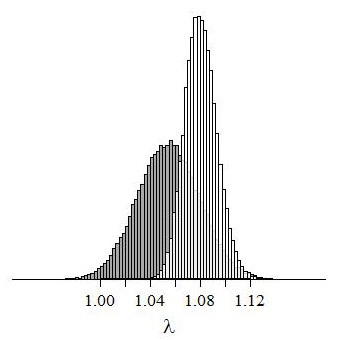The main focus of my research is the application and development of statistical methods in ecological and environmental research. My aim is to use statistics to improve scientific inference, and to make better decisions in the face of uncertainty. Since most science is done by non-statisticians, I try to develop methods that can be widely used and understood.
Ecological Statistics
How does incidental mortality from fisheries affect seabird populations? What will happen to our oceans under a changing planet? We need ecologists, chemists, geologists, statisticians, and many other specialists to use their combined knowledge to start answering these important questions. I develop and apply methods to help answer these types of questions, whether that's using population modelling to estimate fisheries impacts or designing experiments to better understand the biological impact of our changing ocean.
Population modelling
Population modelling is one of the most important tools we can use to understand the impacts or potential impacts of humans on wildlife. For example, it is well-known and easy to show that populations of long-lived animals are most sensitive to changes in adult survival. Statisticians have long been involved in the estimation of important demographic parameters, and in understanding the conservation implications of changes in those parameters.
Many of the populations I have worked on (primarily long-lived marine species such as seabirds, marine mammals, and sharks) are lacking even basic demographic data, but are known to be suffering high levels of mortality from fishing operations. Recent work funded by the Lenfest Ocean Program focussed on developing management models for these data-deficient marine megafauna. This follows earlier work on the Potential Biological Removal method for birds, which has been used to manage seabird bycatch and assess risk to birds from new windfarms. A current focus is developing methods useful for shark populations, many of which are plummeting. This has led to a novel method that integrates species-specific and broad ecological knowledge. The new, integrated methods improve both point estimates and precision compared to standard methods (Fig. 1).

Figure 1: A comparison of standard matrix model (grey) and integrated (clear) estimates of the intrinsic annual growth rate of the white-chinned petrel.
Our changing ocean
The addition of CO2 to our atmosphere isn't just warming the planet: it's causing ocean acidification, affecting nutrient levels, and changing many other fundamental variables that have direct consequences on marine life. Some species may benefit while many will not, and we may see profound changes to primary oceanic producers. As a statistician, I help study this by designing manipulative experiments to study the role of multiple stressors on organisms such as algae and plankton.
Statistical modelling
Model-averaging
Model-averaging combines information from multiple models through the use of model weights. In some situations, such as factorial experiments, model-averaging is a good approach to gaining a large amount of precision by introducing a small amount of bias. Assessing performance of different model-averaging methods, developing new methods, and considering design implications are all of interest.
Lack-of-fit adjustments in Bayesian models
Hierarchical Bayesian models are incredibly flexible and easy to build. Because of this, they have become a standard modelling tool for researchers everywhere from archaeology to zoology. However, better model diagnostics and adjustments are needed. Our aim is to build diagnostic tools that can be used for simple pot-hoc adjustments of credible intervals.
Bayesian models for ion-selective electrodes
ISEs are low-cost instruments capable of detecting sub-micromolar concentrations of various analytes. While collaborators at a number of institutions develop new ISEs, we focus on improved calibration and ISE characterisation methods. We are designing next-generation ISEs, both lab-based and field-deployable, capable of deployment in sensor arrays. By using sensor arrays and our nonlinear Bayesian calibration, we are able to extends limits of detection and provide realistic estimate of measurement precision. Tutorials and software (using R and OpenBUGs) are available.